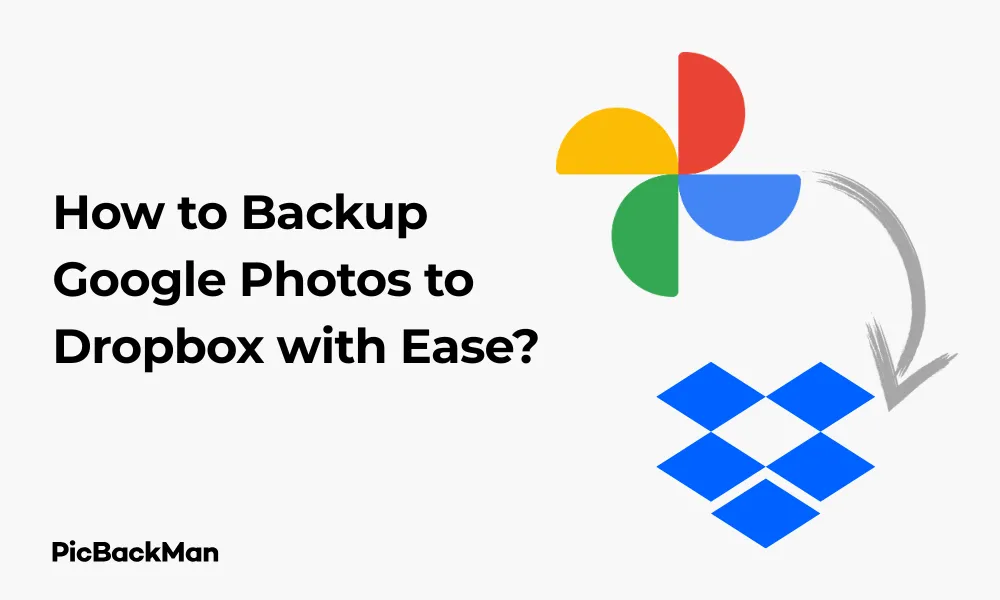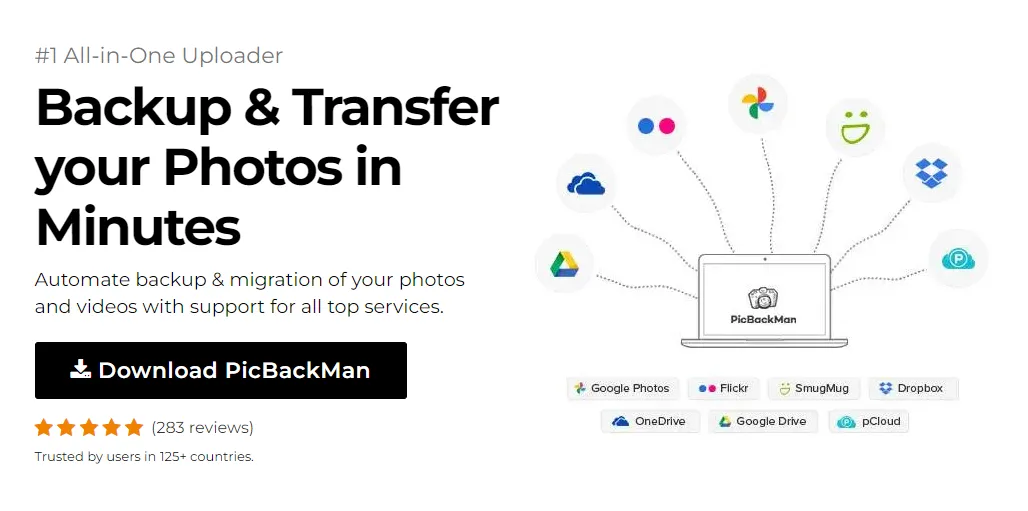
Why is it the #1 bulk uploader?
- Insanely fast!
- Maintains folder structure.
- 100% automated upload.
- Supports RAW files.
- Privacy default.
How can you get started?
Download PicBackMan and start free, then upgrade to annual or lifetime plan as per your needs. Join 100,000+ users who trust PicBackMan for keeping their precious memories safe in multiple online accounts.
“Your pictures are scattered. PicBackMan helps you bring order to your digital memories.”
How to Backup Google Photos to Dropbox with Ease?


Keeping your photos safe is crucial in today's digital age. While Google Photos offers excellent storage options, creating a secondary backup on Dropbox adds an extra layer of security for your precious memories. In this guide, I'll walk you through simple, effective methods to backup your Google Photos to Dropbox, helping you safeguard your visual memories against potential data loss.
Why Backup Google Photos to Dropbox?
Before diving into the how-to steps, let's quickly look at why you might want to create this backup:
- Protection against account lockouts
- Extra security if one service experiences data issues
- More control over your photo organization
- Peace of mind with multiple storage locations
- Different sharing capabilities between platforms
Method 1: Manual Download and Upload
The most straightforward approach involves manually downloading your Google Photos and uploading them to Dropbox. While this requires more hands-on work, it gives you complete control over which photos get backed up.
Step 1: Download photos from Google Photos
- Go to Google Photos and sign in to your account
- Select the photos you want to backup (hold Shift to select multiple consecutive photos)
- Click the three dots in the top-right corner
- Select "Download" from the dropdown menu
- Wait for your photos to download as a ZIP file
- Extract the ZIP file to a folder on your computer
Step 2: Upload photos to Dropbox
- Log in to your Dropbox account
- Click the "Upload" button in the top-right corner
- Select “Files” or “Folder” depending on how you want to organize your photos
- Navigate to and select the photos you downloaded from Google Photos
- Click "Open" to begin the upload process
- Wait for the upload to complete (time varies based on file size and internet speed)
Pros and Cons of Manual Transfer
| Pros | Cons |
|---|---|
| Complete control over which photos to backup | Time-consuming for large photo collections |
| No third-party tools required | Must be done regularly to keep backups current |
| Can organize photos during the process | Potential for human error (forgotten files) |
| Free method (no additional costs) | Requires stable internet connection for large transfers |
Method 2: Using Google Takeout
Google Takeout is Google's data export service that allows you to download data from various Google services, including Google Photos. This method works well for backing up your entire photo library at once.
Step 1: Export Your Google Photos
- Visit Google Takeout
- Sign in with your Google account
- Click "Deselect all" since we only want Google Photos
- Scroll down and select "Google Photos"
- Click "All photo albums included" to customize which albums to export (or keep all selected)
- Scroll down and click "Next step"
- Choose your delivery method (one-time download is recommended)
- Select file type (ZIP is usually best) and size (recommend 2GB for easier handling)
- Click "Create export"
Google will now prepare your export, which may take minutes to hours depending on the size of your photo library. You'll receive an email when your export is ready to download.
Step 2: Download Your Google Photos Export
- Open the email from Google when your export is ready
- Click the "Download your files" button
- Sign in to your Google account if prompted
- Download the ZIP file(s) to your computer
- Extract the ZIP file(s) to a folder on your computer
Step 3: Upload to Dropbox
- Log in to your Dropbox account
- Create a new folder for your Google Photos backup if desired
- Click the "Upload" button
- Select "Folder"
- Navigate to and select the extracted Google Photos folder
- Click "Upload" and wait for the process to complete
Tips for Google Takeout Method
- If your photo library is large, Google will split it into multiple ZIP files
- Download all ZIP files before beginning the upload to Dropbox
- Consider using the Dropbox desktop app for larger uploads as it's more reliable than the web interface for large transfers
- Keep track of when you last did a Takeout export to maintain current backups
Method 3: Using Third-Party Automation Tools
If you want a more automated solution that keeps your Google Photos and Dropbox in sync without manual intervention, third-party automation tools are your best bet.
Option 1: Using PicBackMan
PicBackMan is a dedicated cloud uploader and migration tool that supports Google Photos, Dropbox, and many other services.
Steps to Set Up PicBackMan for Google Photos → Dropbox
- Download & install PicBackMan on your computer (Windows or macOS).
- Open PicBackMan and go to the Accounts tab. Connect both your Google Photos and Dropbox accounts.
- Go to the Migrate tab. Click Choose Account to Migrate and select Google Photos as the source, then select Dropbox as the destination.
- Click Migrate to start the transfer — PicBackMan runs the migration in the background.
Why use PicBackMan?
- Maintains your existing folder structure during transfer.
- Smart de-duplication to avoid duplicate uploads.
- Offers a free tier and affordable paid plans for larger libraries.
Option 2: Using IFTTT (If This Then That)
IFTTT is a popular automation platform that can create connections between different web services.
Steps to Set Up IFTTT:
- Go to IFTTT and sign up for an account
- Click "Create" to make a new applet
- Click "If This" and search for Google Photos
- Connect your Google Photos account if prompted
- Select a trigger (eg, “Any new photo added to your library”)
- Click "Then That" and search for Dropbox
- Connect your Dropbox account if prompted
- Select the action "Add file from URL"
- Configure where in Dropbox you want photos saved
- Click "Create Applet" to activate
Limitations of IFTTT Method:
- IFTTT free plan has a limited number of apps
- Only works for new photos added after setting up the applet
- May not transfer original quality photos in all cases
- Can't easily backup your existing photo library
Option 3: Using Zapier
Zapier is another automation tool that offers more powerful features than IFTTT but may come with a subscription cost for larger photo libraries.
Steps to Set Up Zapier:
- Go to Zapier and create an account
- Click "Make a Zap"
- Search for and select Google Photos as your trigger app
- Connect your Google Photos account
- Choose "New Photo" as your trigger event
- Test the trigger to make sure it works
- Add Dropbox as your action app
- Connect your Dropbox account
- Select "Upload File" as the action
- Configure the file path and settings
- Test and activate your Zap
Method 4: Using Dropbox Desktop App with Google Photos Download
This method combines the Google Photos download feature with the automatic syncing capability of the Dropbox desktop app.
Step 1: Set Up Dropbox Desktop App
- Download and install the Dropbox desktop app if you haven't already
- Sign in to your Dropbox account
- Create a dedicated folder for your Google Photos backup
- Make sure the folder is set to sync with your Dropbox account
Step 2: Download Photos from Google Photos to Your Dropbox Folder
- Go to Google Photos
- Select the photos or albums you want to backup
- Click the three dots menu and select "Download"
- When the download completes, extract the ZIP file if necessary
- Move or copy the photos directly to your Dropbox sync folder
Step 3: Let Dropbox Sync Automatically
The Dropbox desktop app will automatically detect the new files and begin uploading them to your Dropbox cloud storage. You can check the sync status by clicking on the Dropbox icon in your system tray or menu bar.
Advantages of this method:
- More reliable uploads for large collections
- Automatic resuming if your internet connection drops
- No need to manually upload through the Dropbox web interface
- Can organize photos into folders as you move them
Quick Tip to ensure your videos never go missing
Videos are precious memories and all of us never want to lose them to hard disk crashes or missing drives. PicBackMan is the easiest and simplest way to keep your videos safely backed up in one or more online accounts.
Simply download PicBackMan (it's free!) , register your account, connect to your online store and tell PicBackMan where your videos are - PicBackMan does the rest, automatically. It bulk uploads all videos and keeps looking for new ones and uploads those too. You don't have to ever touch it.
Comparison of All Methods
| Method | Ease of Use | Time Required | Automation | Cost | Best For |
|---|---|---|---|---|---|
| Manual Download / Upload | Easy | High | None | Free | Small collections, selective backup |
| Google Takeout | Medium | Medium | None | Free | Complete library backup |
| PicBackMan | Medium | Low | Full | Free / Paid | Automated backups with folder structure |
| IFTTT | Medium | Low | Full | Free / Premium | New photos only |
| Zapier | Medium | Low | Full | Free / Premium | Advanced automation needs |
| Dropbox Desktop App | Easy | Medium | Partial | Free | Large collections, reliable transfer |
Tips for Efficient Google Photos to Dropbox Backup
Managing Storage Space
Both Google Photos and Dropbox offer limited free storage. Here are some tips to manage your space efficiently:
- Consider backing up only your most important photos if storage is limited
- Use Google Photos' "High Quality" option to save space before exporting
- Organize photos into albums before transferring to make management easier
- Regularly clean up duplicates in both services
- Consider paid plans if you have large photo libraries
Maintaining Organization
Keeping your photos organized during transfer will save you headaches later:
- Create a consistent folder structure in Dropbox before starting transfers
- Consider organizing by year/month or by event
- Use descriptive folder names that will make sense in the future
- Keep track of what you've already backed up to avoid duplicates
- Consider adding tags or descriptions in Dropbox for easier searching
Scheduling Regular Backups
To keep your Dropbox backup current with your Google Photos:
- Set a regular schedule (monthly, quarterly) for manual backups
- Add calendar reminders for Google Takeout exports
- Use automated tools for real-time or scheduled syncing
- Consider incremental backups (only new photos) to save time
Troubleshooting Common Issues
Handling Failed Uploads
If you encounter issues during the upload process:
- Check your internet connection stability
- Try uploading smaller batches of photos
- Use the Dropbox desktop app instead of the web interface
- Ensure you have enough storage space in your Dropbox account
- Clear your browser cache if using web uploads
Dealing with Metadata Loss
Sometimes photo metadata (date taken, location, etc.) can be lost during transfers:
- Google Takeout generally preserves metadata better than manual downloads
- Check that dates and times are preserved after transfer
- Consider specialized photo management software if metadata is critical
- Test a few photos first to verify metadata preservation
Handling Large Photo Libraries
For very large collections (thousands of photos):
- Break the process into smaller batches by album or date range
- Use a wired internet connection rather than Wi-Fi when possible
- Consider overnight transfers for minimal disruption
- Use the Dropbox desktop app with selective sync for better control
- Monitor your computer's performance during large transfers
Frequently Asked Questions
Can I automatically sync all new Google Photos to Dropbox?
Yes, you can set up automatic syncing using third-party tools like MultCloud, IFTTT, or Zapier. These services can be configured to detect new photos added to Google Photos and automatically transfer them to your Dropbox account, creating a real-time backup solution without manual intervention.
Will I lose photo quality when transferring from Google Photos to Dropbox?
If you download your photos at original quality from Google Photos, there should be no quality loss when uploading to Dropbox. However, if your Google Photos are stored in “High Quality” (compressed) format, they will remain compressed when transferred. For maximum quality, ensure you're storing and downloading original quality photos.
How much storage do I need in Dropbox to backup all my Google Photos?
You'll need approximately the same amount of storage in Dropbox as your Google Photos collection size. To check your Google Photos storage usage, go to Google One storage management. Free Dropbox accounts offer 2GB of storage, while paid plans offer more. Consider selective backups if your photo collection exceeds your available Dropbox storage.
How long does it take to transfer a large Google Photos library to Dropbox?
Transfer time depends on your internet connection speed and the size of your photo library. For reference, transferring 10GB of photos on a 50Mbps upload connection would take approximately 30 minutes under ideal conditions. Larger libraries (100GB+) might take several hours or even days. Using desktop apps and wired connections can improve transfer speeds.
Can I keep my Google Photos folder structure when backing up to Dropbox?
Yes, when using Google Takeout, your album structure is generally preserved in the exported files. When using MultCloud or desktop app methods, you can maintain your folder organization. Manual transfers also allow you to recreate your desired folder structure in Dropbox. IFTTT and Zapier require more configuration to maintain folder structures but can be set up to organize photos by date or other criteria.
Conclusion
Backing up your Google Photos to Dropbox provides valuable redundancy for your precious memories. Whether you choose the manual approach for occasional backups, Google Takeout for complete library transfers, or automated tools for ongoing synchronization, you now have the knowledge to protect your photos effectively.
The best method depends on your specific needs: manual methods give you more control but require more effort, while automated solutions save time but may have limitations or costs. By following the steps outlined in this guide, you can create a robust backup system that ensures your photos remain safe regardless of what happens to any single storage service.
Remember that the most important aspect of any backup strategy is consistency. Set up a regular schedule, check your backups occasionally, and adjust your approach as your photo collection grows. With these practices in place, you can enjoy peace of mind knowing your visual memories are securely stored in multiple locations.






